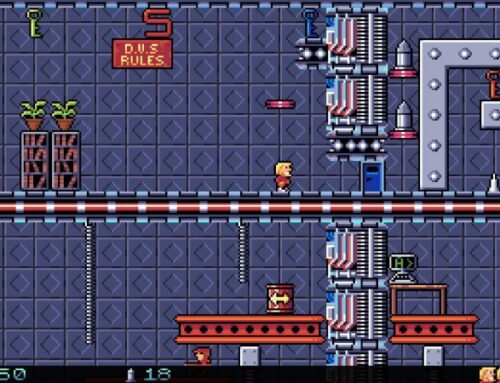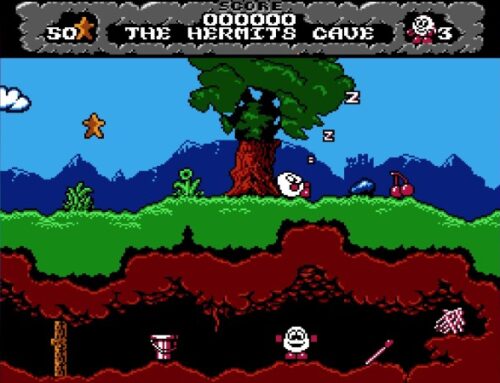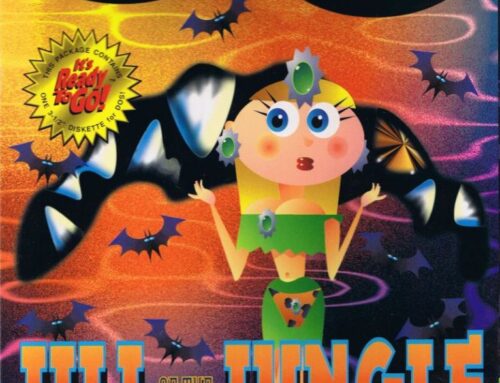
We’re not all grizzled retro gaming veterans — some of us are new to the hobby. So our Getting Into Retro Gaming guides are here to help you get up and running as soon as possible — and ponder some common thoughts you might have on your own personal journey.
First released in 1978, the Philips G7000 Videopac Computer, known in North America as the Magnavox Odyssey 2, was one of the four major home video game consoles prior to the “great crash” of 1983, alongside the Atari 2600, Mattel’s Intellivision and the ColecoVision.
As the North American name suggests, the Magnavox Odyssey 2 is a successor to the company’s first home console, 1972’s Odyssey. Comparatively speaking, the Magnavox Odyssey 2/Philips G7000 was a massive technological step forwards, since the older hardware could only display three square dots and one line of varying height on the screen at once; the newer unit, meanwhile, had full alphanumeric character support in multiple colours, four hardware sprites, background support and plenty more besides.
While the system is a lot less well-known than its contemporaries, there are a lot of great games available for the platform — and the relatively small library means that amassing a complete collection is an absolutely attainable dream, with only a few titles commanding notably high prices.
The Philips G7000/Magnavox Odyssey 2 system

There are a few different models of the Philips G7000 or Magnavox Odyssey 2, beginning with the simple difference between the two differently named versions. The Philips G7000 was released in Europe, supports PAL televisions and has no power button; simply plugging the unit in turns it on. The Magnavox Odyssey 2, meanwhile, supports NTSC televisions and features a power button.
Less common are some branded variants that were released in various parts of Europe. The Philips Videopac C52, for example, was released in France and supports SCART SECAM connections to televisions. You may also come across the Radiola Jet 25, Schneider 7000 and Siera G7000; these are all the same machine at heart. There’s also a very rare European model known as the Philips G7200, which features a built-in black and white monitor.
The system was released in Brazil as the Philips Odyssey, and proved very popular. There was also a Japanese release by Kouton Trading Toitarii Enterprise, where it was simply known as the Odyssey 2; it was not at all successful in the region, making Japanese variants some of the rarest versions of the system to find.
Early models of the G7000 in particular have detachable joysticks; later models have the joysticks hardwired into the system.
There are also some later versions of the platform known as the G7400 Videopac+ and Brandt Jopac JO 7400 (“Jopac” for short); these feature enhanced graphical capabilities but remain backwards compatible with the existing library of software. There are also a few titles that were specifically released exclusively for these enhanced systems.
Media

Media is, like many systems from the period, extremely straightforward: the system runs on ROM cartridges which have remained highly reliable over the years. The cartridges themselves are in chunky plastic casings with a handle to make removal easier, and in Europe they were typically boxed in hard plastic cases with a combined manual and inlay providing cover art.
European releases are all numbered, and there are several variants of each cartridge: some have a simple black cover with a red number, while other releases feature distinct artwork for each cartridge, with the number in the upper corner of the inlay.
In North America, Odyssey 2 games were not numbered and typically came in cardboard boxes. They usually had different names to their European counterparts — in some cases changing the context of the game entirely. For example, the European game Gunfighter (cartridge 14) was known as “Showdown in 2100 A.D.” in North America, changing the context from a Western-style quick-draw competition to battling androids in space. None of the actual graphics were changed, however.
An interesting quirk of the North American releases is that they typically had exclamation marks at the end of their titles; in fact, the only which doesn’t is the aforementioned Showdown in 2100 A.D.
North American Odyssey 2 releases are mostly compatible with European models, though there are the usual NTSC-PAL colour palette differences. The only exceptions to cross-compatibility were Frogger, whose American version does not work on European Philips G7000 consoles, and Chess, which does not work on American Magnavox Odyssey 2 units.
Peripherals

There are a few expansion modules available for the Philips G7000/Magnavox Odyssey 2, but none are a particularly essential purchase.
The Voice module provides speech synthesis and enhanced sound effects for games which support it, but unlike the similar Intellivoice module for Intellivision, The Voice was not required to play these games.
The C7010 Chess Module includes a second CPU and extra memory to run the chess program available for the console, since the base specifications of the system were not up to running a convincing game of chess by themselves.
Finally, there is a Home Computer Module, model number C7420, available for the later Videopac+ and Jopac models of the system. This included an implementation of Microsoft Basic, which took the system from being a simple games console to a relatively primitive home computer — you could even save programs you had written to cassette. The module was not successful due to being a contemporary of platforms such as the Atari 8-bit range of computers, which offered much more flexibility.
Software

There were 50 first-party releases for the base Philips G7000 system; most of these had North American counterparts for the Odyssey 2, but there were a number of games which came out in Europe but not the States.
Cartridges 51 to 60 in the library are designed for play on the newer Videopac+ and Jopac systems, though some will also work on the base Philips G7000 system. Several entries in the 1-50 lineup also have “+” variants available with optional graphical enhancements — usually background art — for the Videopac+ and Jopac systems.
Imagic released Atlantis and Demon Attack for the platform, but both are rather hard to find — as are the four Parker releases Frogger, Popeye, Q*Bert and Super Cobra.
Prices vary quite a bit from game to game; expect to pay anywhere between £5 and £15 for an individual game from the first-party lineup depending on if it is boxed and in good condition. eBay sellers often do job lots of games, so shop around for a good deal.
The rarest, most expensive games are numbers 41 and 42 in the library: Conquest of the World and Quest for the Rings respectively. These games were distinct in that they came with a board game element, and the video game was designed to resolve conflicts which occurred in the board game. These are typically listed for around £40 or so, but check the descriptions to ensure they’re complete if you actually want to play them.
Killer apps

Gunfighter/Showdown in 2100 A.D. is one of the best known games for the platform not just for the ridiculous inconsistency between its European and North American title and theming, but because it’s an excellent game for one or two players. Each player controls a gunfighter and has to shoot the other player. First to ten points wins. The twist? You only have six bullets before you need to reload — and in order to reload you need to touch a tree that is the same colour as you. Oh, also, bullets ricochet off all the trees, so watch where you’re shooting.

Satellite Attack/UFO! is an absolutely fantastic multidirectional shooter that features elements of Asteroids and Missile Command. Blast the incoming enemies and attempt to create chain reactions of explosions. Watch out for the deadly saucers and do your best to achieve a high score — this is one of a number of games for the Philips G7000/Magnavox Odyssey 2 which allows you to use the system’s keyboard to type in your name (or rude words) if you beat the high score for that session.

Munchkin/K.C. Munchkin! is probably the most well-known game for the Philips G7000 and Magnavox Odyssey 2 because its release resulted in a lawsuit from Atari. Atari had the license to release the home version of Namco’s Pac-Man, you see, and Munchkin is quite similar to Pac-Man — though not an exact clone. It did, however, hit store shelves a year before Atari’s notoriously terrible Atari 2600 Pac-Man was ready, though. Atari lost its case initially, but ultimately won on appeal; the ruling was a defining case in how copyright law would apply to the look and feel of computer software.

Crazy Chase/K.C.’s Crazy Chase! was released after Atari’s lawsuit forced Munchkin off the market. It’s a similar kind of game — and very playable — but more obviously distinct from Pac-Man this time around; the protagonist character now rolls rather than chomping around like Pac-Man, and instead of eating dots he’s trying to consume a centipede-like character. Some believe that Crazy Chase is a direct response to the lawsuit, with Munchkin representing Philips and the centipede-esque character representing Atari — a reference to their popular Centipede arcade game.

Pickaxe Pete/Pickaxe Pete!, one of the few games to actually maintain its name between its European and North American incarnations (albeit with an exclamation mark in the latter case), is an excellent platform game in which you have to smash boulders, collect keys and escape through doors. In Brazil, this game was rebranded to Didi na Mina Encantada, after a popular character portrayed by Brazilian comedian Renato Aragão.
Philips G7000/Magnavox Odyssey 2 emulation and modern options
Emulation for the Philips G7000/Magnavox Odyssey 2 is in a good state, with the best emulator being O2EM. There are a couple of titles whose sound doesn’t quite work properly in the emulator, but for the most part performance is very good. O2EM is also available as a core for Retroarch. Note that regardless of how you run O2EM, you’ll need to provide your own BIOS files and games.
Emulating Philips G7000/Magnavox Odyssey 2 is best done on a computer, since while most games simply used the single-button joysticks, the system’s keyboard is typically used to start games in different modes. There are some games that involve typing, too.
There’s been no sign of any modern rereleases or ports of these games, but never say never. In the meantime, the original system is easy to come by, affordable and works just fine even on modern TVs.
Good luck with your new retro gaming journey!
Header image by Evan-Amos (CC BY-SA 3.0)




